Herb garden ideas: 21 ways to grow herbs outdoors and in
Take your pick from these herb garden ideas and you'll always have a fragrant collection of culinary delights to choose from
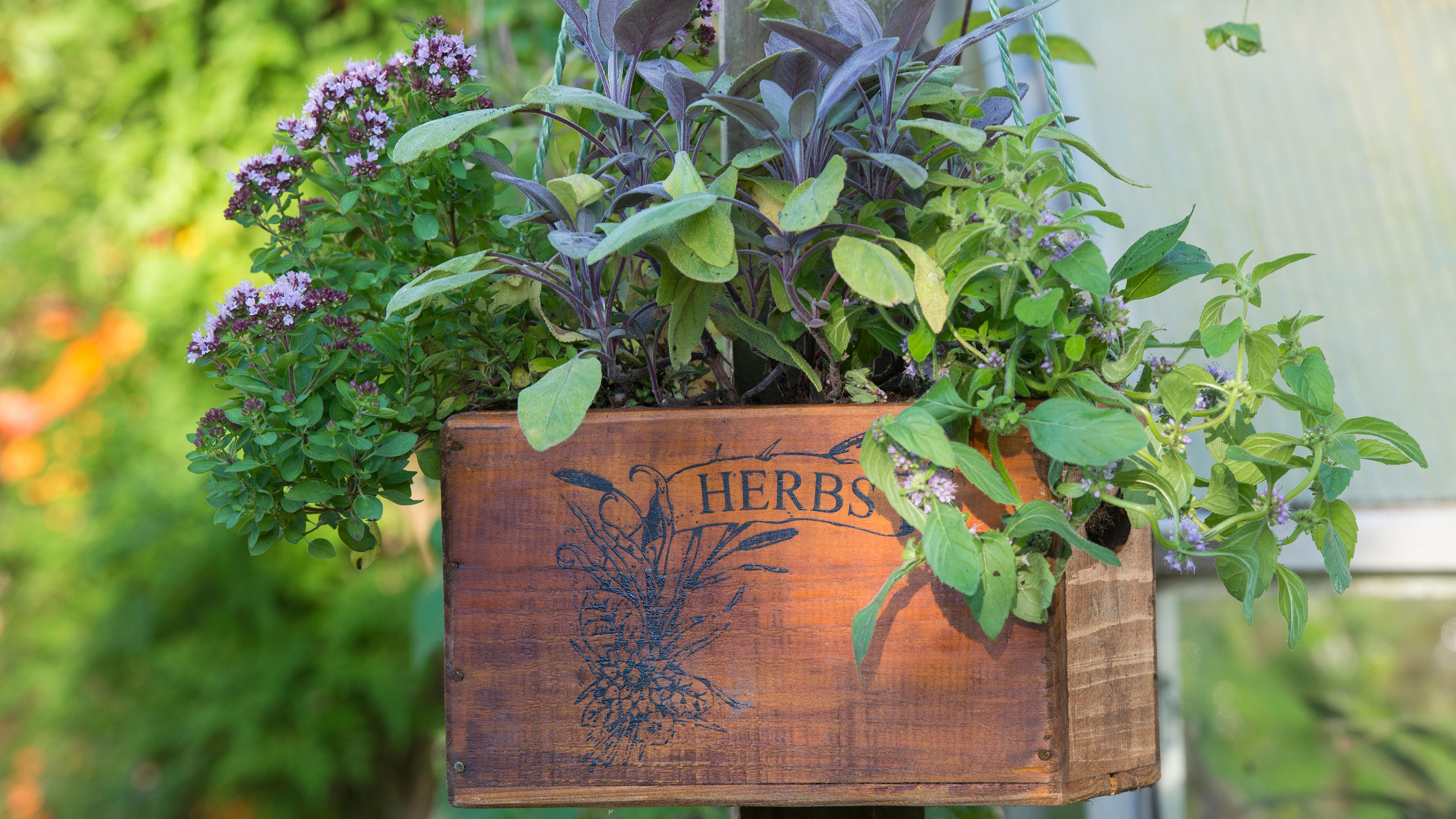

Holly Crossley
You can never have enough herb garden ideas in your plot, whether that's a collection of small pots grouped together or a large planter brimming with your pick of favorites. As well as a pretty display and gorgeous scent it means you will also have a daily supply of fresh herbs to hand for cooking with.
Once you get your herb garden up and running you will end up with a collection that will last for years. As well as the classics such as rosemary, parsley, and thyme, try adding more unusual herbs to the mix like varieties of scented leaf sages such as orange and lemon, and chocolate or ginger mint.
Flowering and aromatic herbs are a magnet for pollinating insects too which will benefit your garden all round, especially if you're growing vegetables.
If space is tight, experiment with arranging your herb collection vertically or in hanging containers to make the most of your growing potential. It also makes your kitchen garden ideas more practical as everything will be in one place.
It's a great upcycling opportunity too, especially if you like the idea of growing everything in one big container.
Get growing with our inspiring herb garden ideas
You'll never be short of fresh produce to add to your favorite dishes with our herb garden ideas. Whether you have a large backyard, a small patio, or just a kitchen windowsill, there are plenty of ways to learn how to create a herb garden in your space.
1. Build a beautiful display with repurposed containers
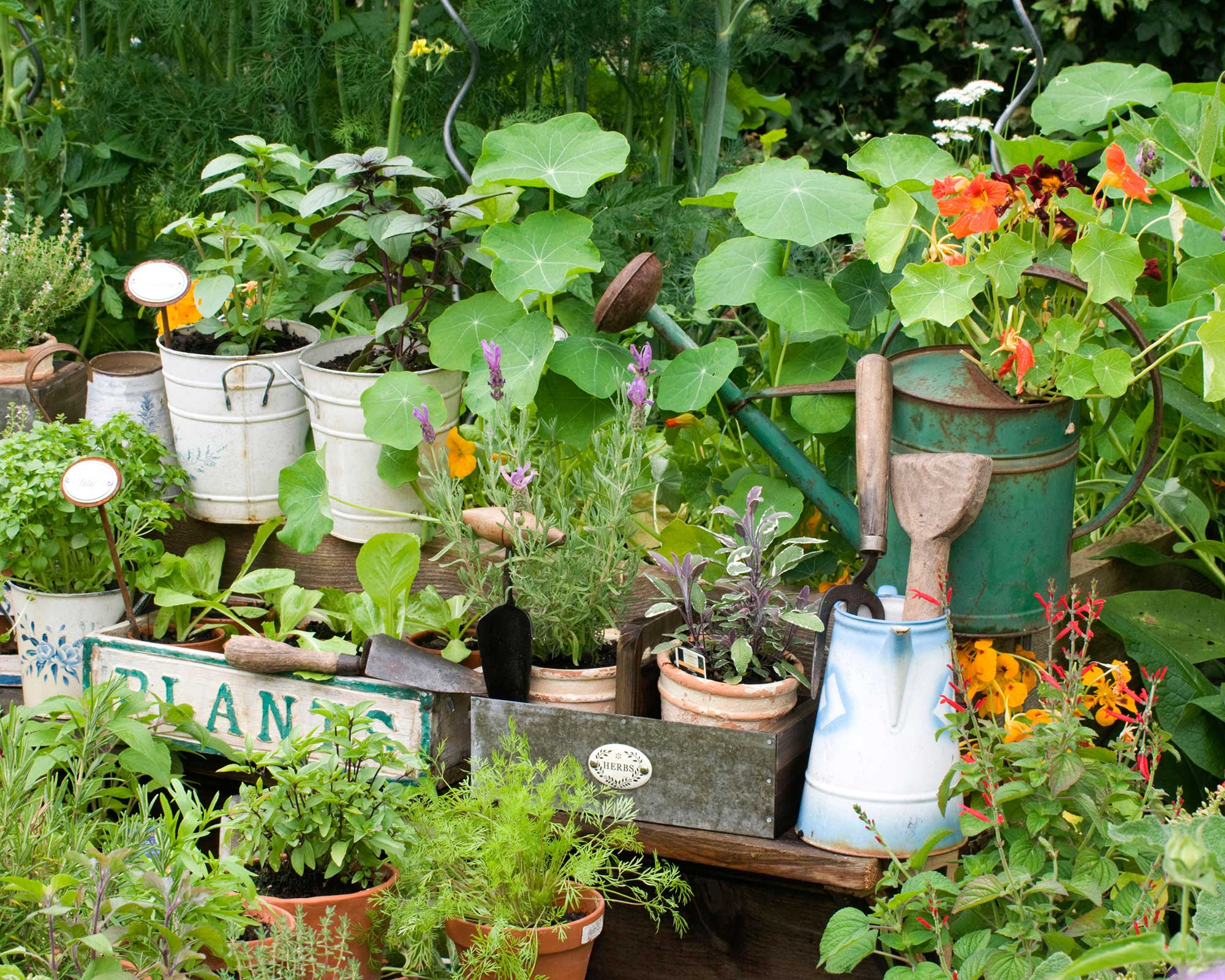
This display is full of life and color and would make a gorgeous addition to a relaxed, bohemian-inspired scheme. And if you're after cheap garden ideas, it ticks that box, too.
Part of its charm is all down to the mix of rustic planters used – from metal buckets to a vintage watering can. Such containers can often be picked up for cheap at secondhand stores or online marketplaces – or you may even have them tucked away at the back of the shed. Just ensure you give them a good clean and dry before using, to keep your herbs healthy and happy.
When arranged together across different levels, the result is stunning. We particularly love the addition of nasturtiums here too, with their bright orange blooms.
2. Label your herbs with DIY signs
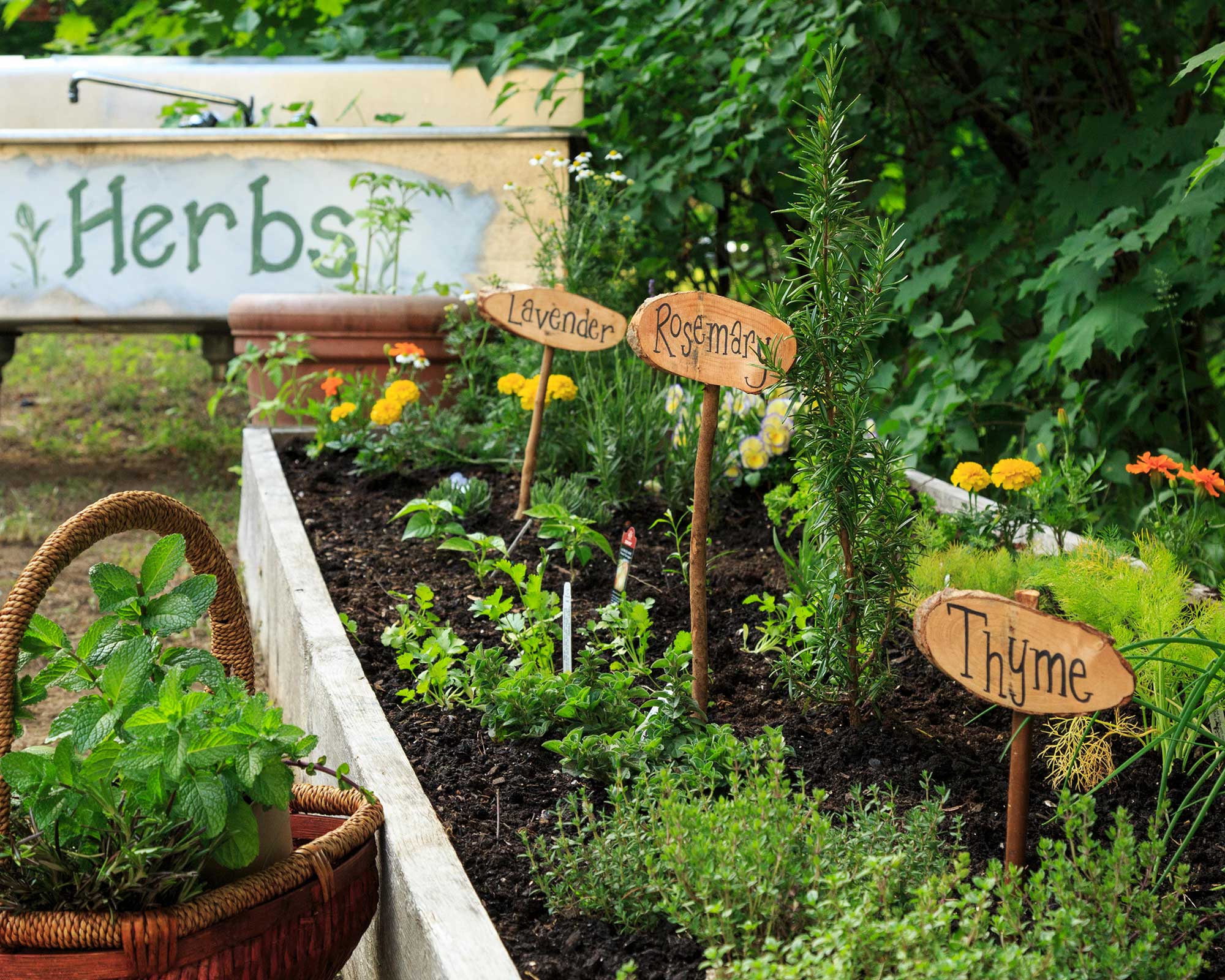
Not only are plant labels useful, but they can also add a pretty touch to your displays. And it's easy to make your own with a bit of exterior paint and a touch of creativity.
You could use small, sawn-off pieces of log or offcuts of timber attached to sturdy twigs pushed into the soil. Or how about decorating large pebbles and nestling them beneath each plant? Wooden spoons are also a thrifty option.
While you've got the paintbrush handy, you may want to consider some garden furniture paint ideas, too. It's a great, budget-friendly way to update a patio and give it extra personality.
3. Incorporate potted herbs into your outdoor kitchen
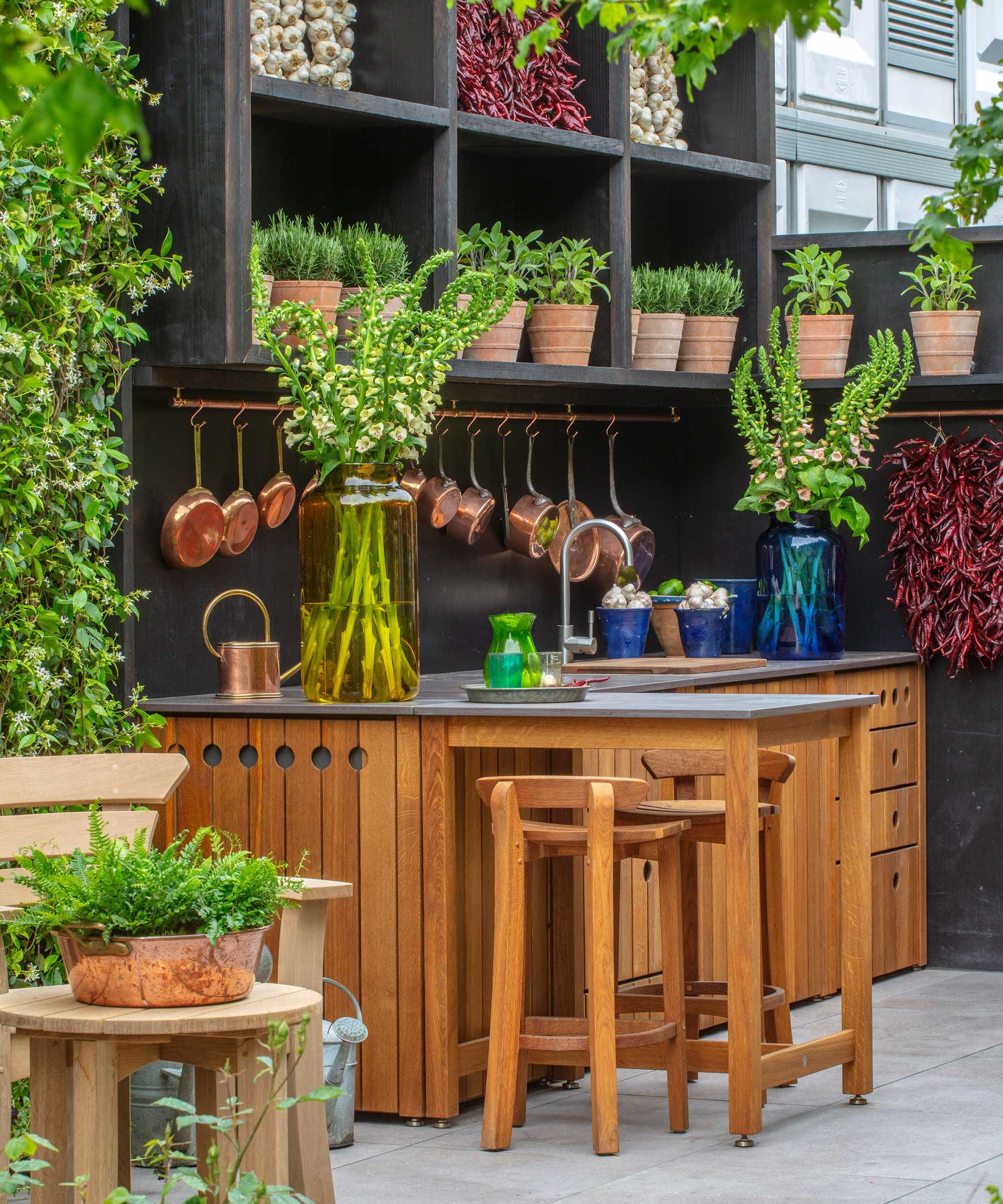
Have you invested in an outdoor kitchen? Or, perhaps you're in the midst of planning one of these on-trend features for your backyard. Well, whether you're going for a simple setup with just the essentials, or a sleek layout with all the latest mod cons, potted herbs make a welcome addition. Picked fresh, they're a great way to elevate your grilled goodies.
Arrange them along the back of countertops in matching containers for a contemporary look. Or, to make more space for food prep, use shelves up high to your advantage. Just ensure they're close enough to be within arm's reach, so you can give your cooking a flavor boost easily.
4. Surround a seating area with fragrant herbs
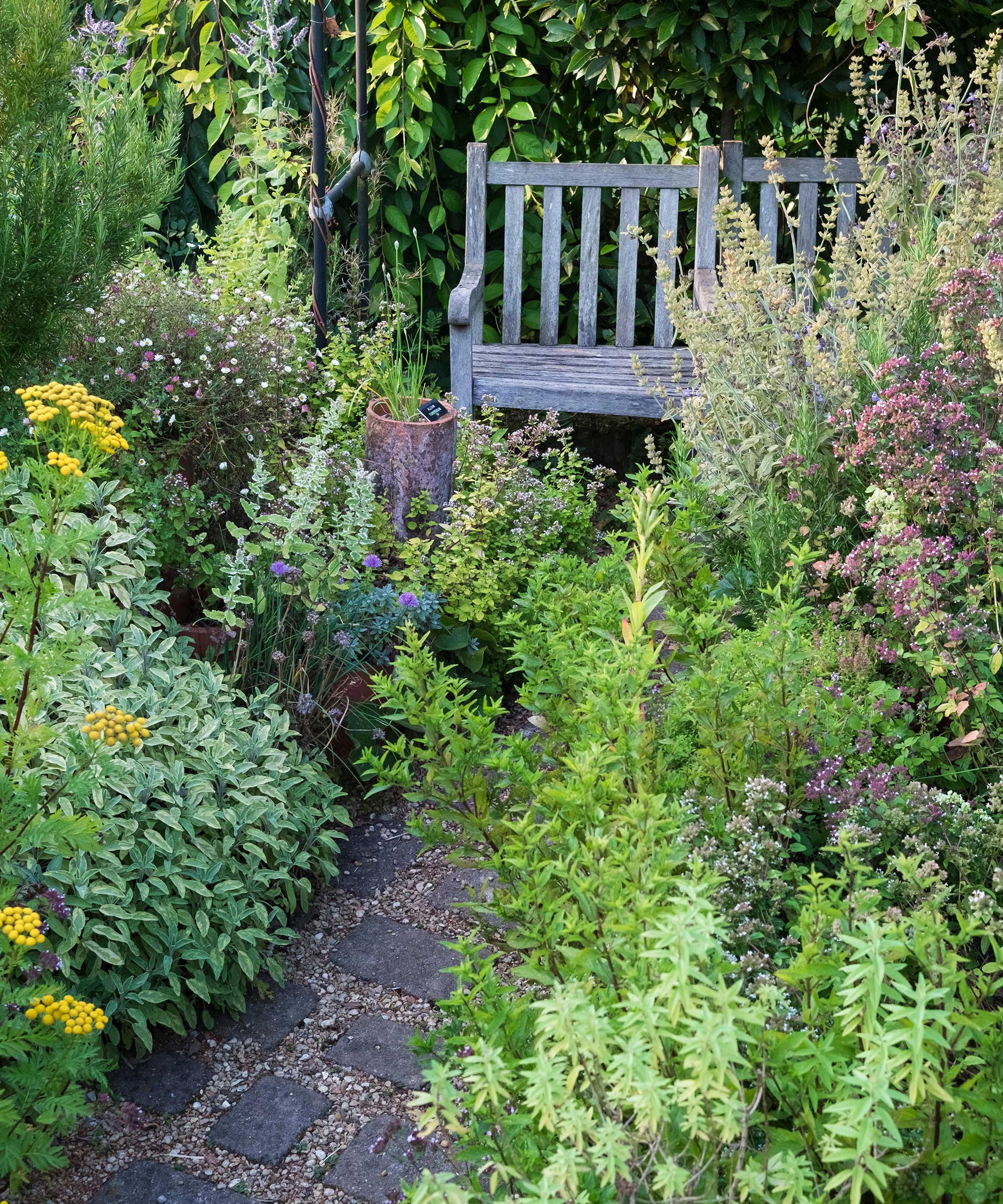
Up the sensory appeal of your outdoor seating ideas by tucking a bench or bistro set amongst your herbs.
Tall varieties, such as fennel and borage, can be used as a soft screen to cocoon the zone and up the sense of privacy. Oregano, chives, rosemary, and thyme make other lovely choices for planting nearby, with their pretty blooms in purple hues. And the best part is, you can enjoy the delicious fragrance as you enjoy the view.
For even more whimsical charm, consider adding an archway over your seat – it'll make the perfect base for a climbing rose.
5. Repurpose glass jars to pep up your wall
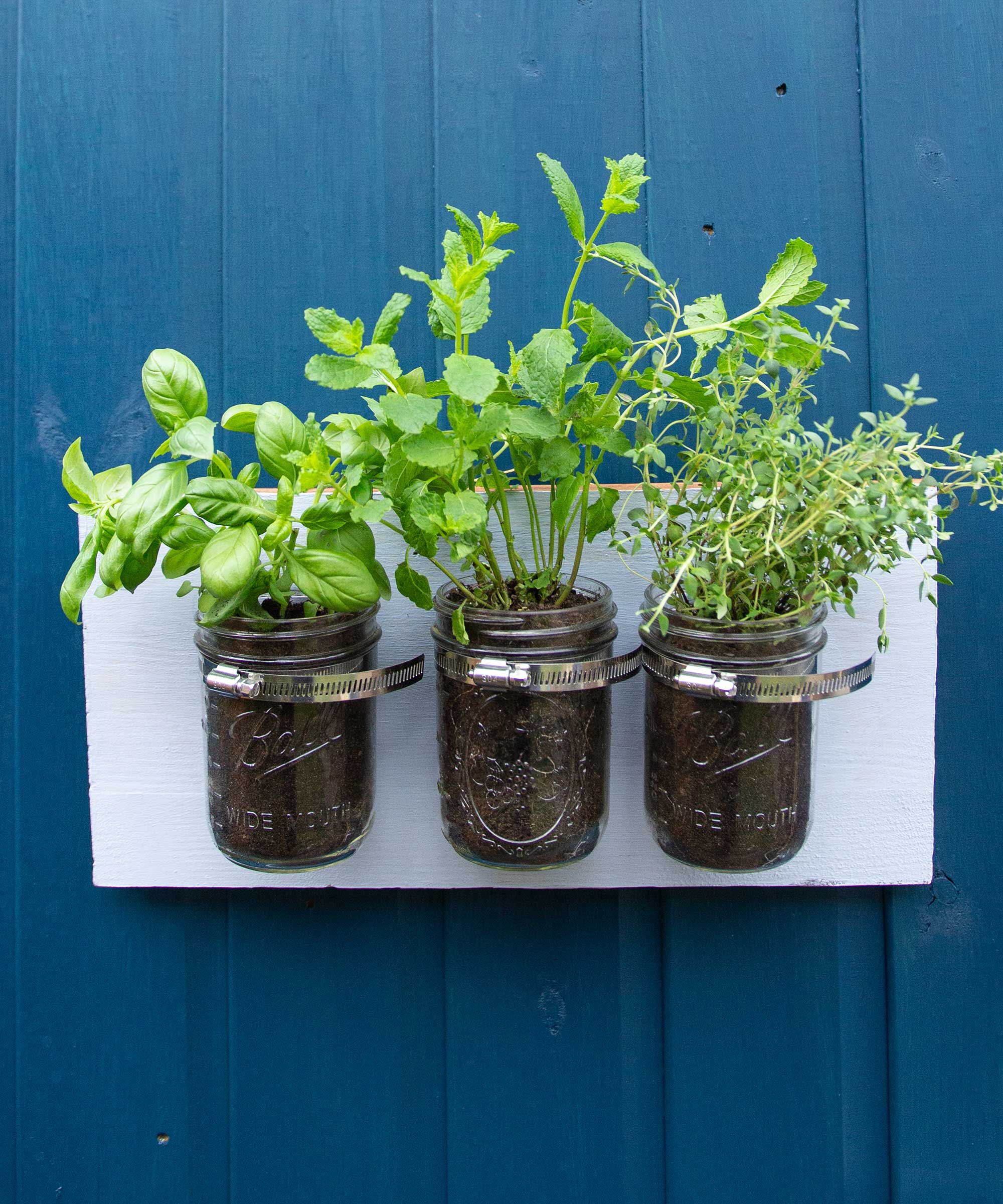
An easy craft project like this looks fabulous and, if you use recycled jars, is good for the environment, too.
As it doesn't take up any floor space, it's a good idea for smaller plots and balcony gardens. Plus, it looks super modern and is a great way to add interest to a blank wall. To make it, you'll need some hose clamps, some screws to secure them, washed-out glass jars, a piece of board, and a hook for hanging it up. The experts at Trex suggest this project as a good way of recycling their composite decking samples.
And if you're not keen on the minimal look, you could always spray paint the exterior of the jars – perhaps in a bright white for a Scandi-chic aesthetic, or for a touch of luxe, a cool copper.
6. Pack a pretty planter with your favorite herbs
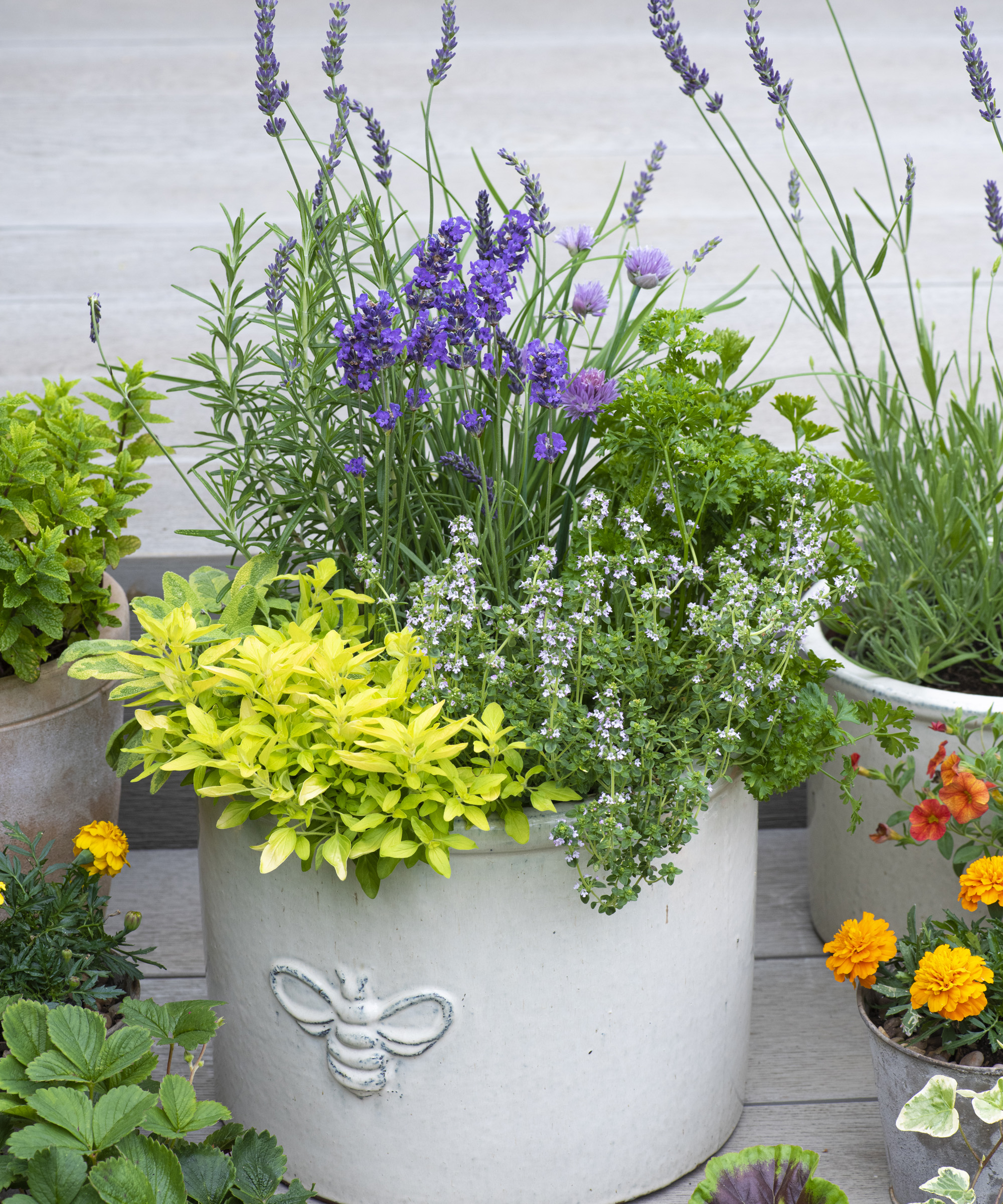
Not got much space? You can still enjoy show-stopping herb garden ideas on a smaller scale by planting up a gorgeous container with your favorite varieties.
Firstly, choose a garden planter to suit your scheme – whether that's a ceramic beauty like this bumblebee design, a contemporary corten steel look, or something else entirely. Then, when it comes to planting, the trick is to choose a mixture of heights, textures, and colors and arrange them so you can see each one clearly.
With our guide on how to plant a herb pot, you can have a display just like the one shown above to admire.
7. Fill a hanging basket
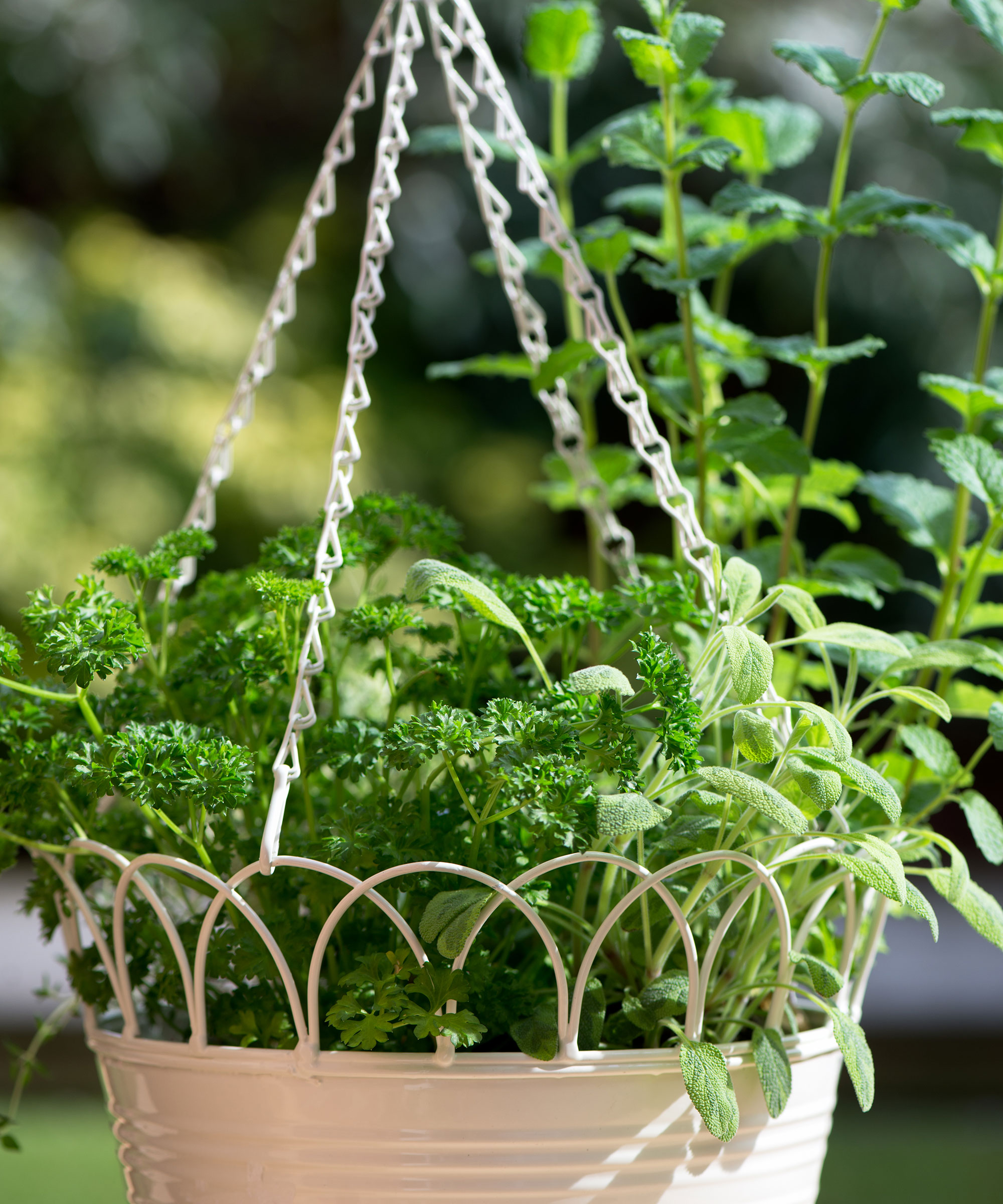
Hanging basket ideas work well in any space and are particularly good for balconies and terraces where there tends to be an expanse of wall to hang things from.
A traditional style of hanging basket will hold enough compost for you to grow a good collection of herbs. This one has a lovely mix of parsley, marjoram, sage, thyme, and mint to cover all your basic herb requirements.
It's important to keep the compost moist and you will need to water them every day in hot weather. But make sure the soil does not become waterlogged, so remember to add slits to the plastic liner so excess water can drain out. That way, your hanging herbs will be happy with their growing space.
If you want herbs that cascade over the edges of the basket, choose trailing forms. Thyme, tarragon, oregano, and sage work well.
8. Plant a vertical herb garden
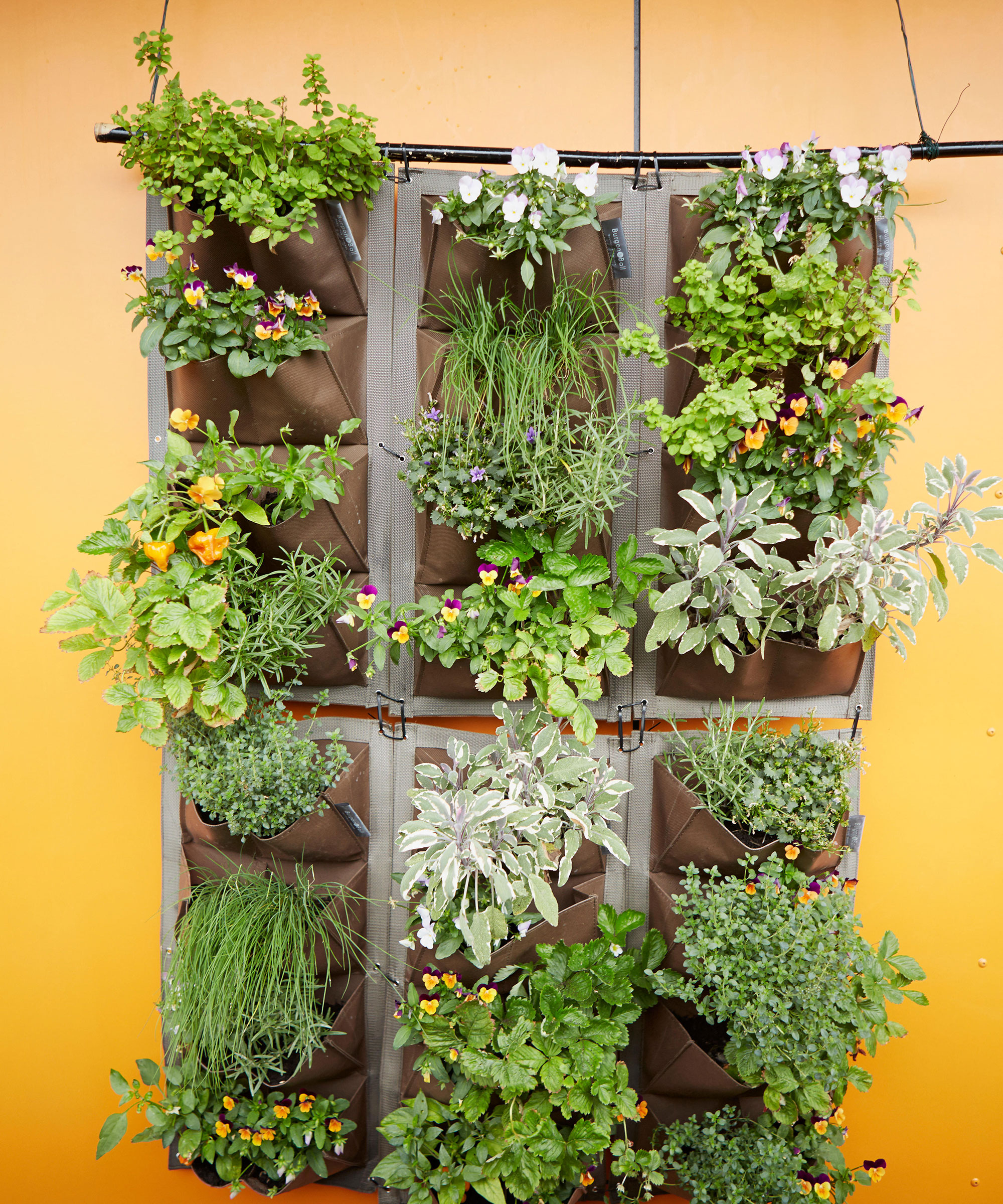
If your growing area is limited, it's worth considering vertical garden ideas so you don't take up too much of your precious ground space.
Herbs are a good choice for vertical planting as they like it dry – you don't need to water them as much as flowers and vegetables. Plants that need more water are likely to do better near the base of a planter like this, where they can receive extra run-off from the plants above.
The best herbs to grow in a vertical planter tend to be smaller plants with a minimal root system, since they weigh less and require less soil. But it very much depends on the size of your vertical garden. Pallet garden wall ideas can also be a brilliant option as they will give you more space for your herb garden, allowing you to grow larger plants.
Take care with some herbs. If you're learning how to grow mint, for example, bear in mind that it can take over. So, grow it in a separate pocket planter to avoid it becoming invasive.
9. Make an easy trellis display
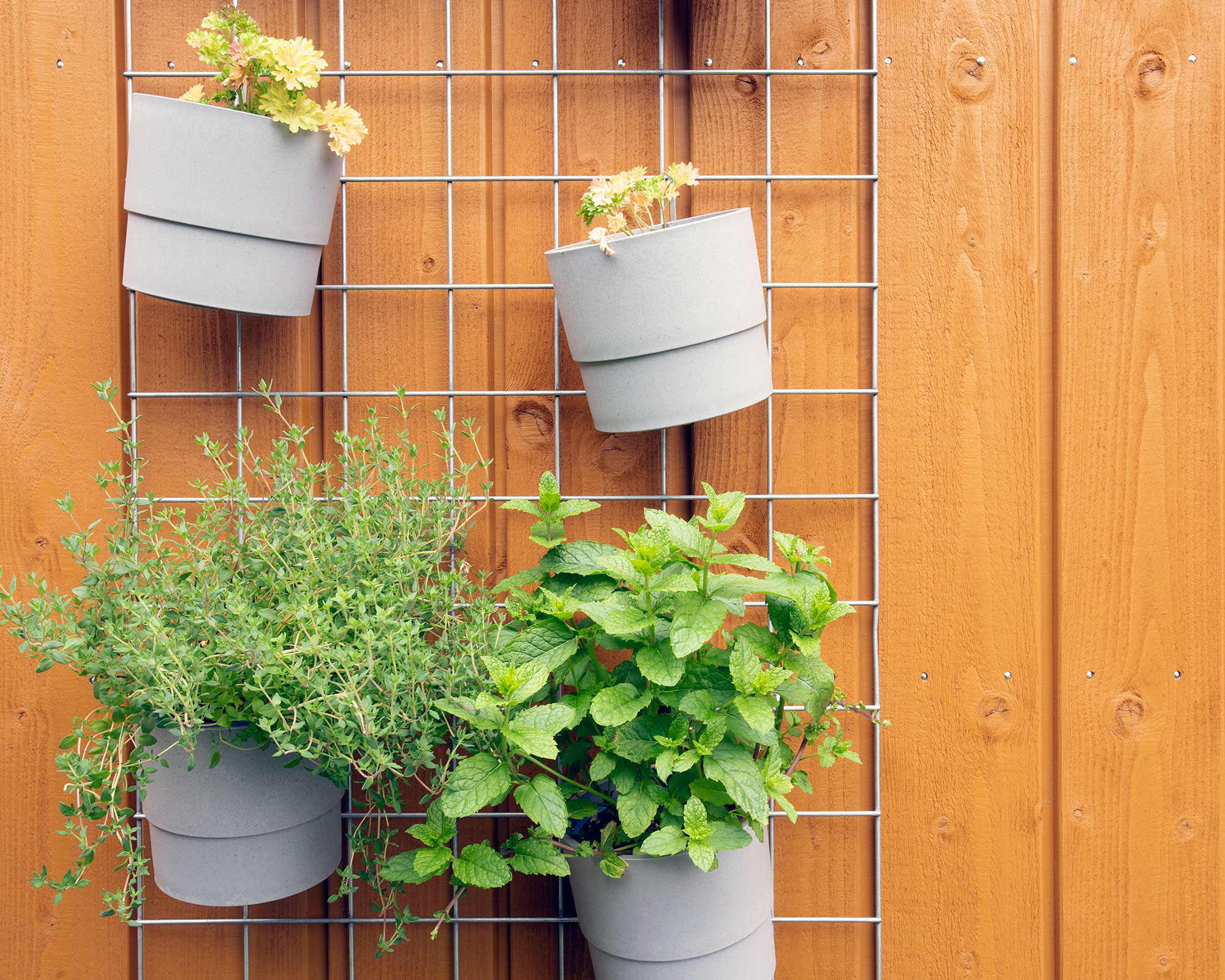
Everyone needs some modern trellis ideas for gardens to instantly max up their growing space. When it comes to herb garden ideas, it's one of the easiest options around.
Trellis is available with varying slat sizes and gap widths, allowing you to choose the best arrangement for your own hanging herb garden.
There's now a huge choice of painted slatted panels to pick from that introduce color and a modern style to any garden or outdoor space. Then all you need to do is choose some pots in complementary colors to hang your herbs.
Quick to put up and creating a good-looking display once done, sometimes the simplest ideas are the best. You could even replicate this look indoors for an interesting and practical addition to your kitchen.
10. Turn a wine box into a planter
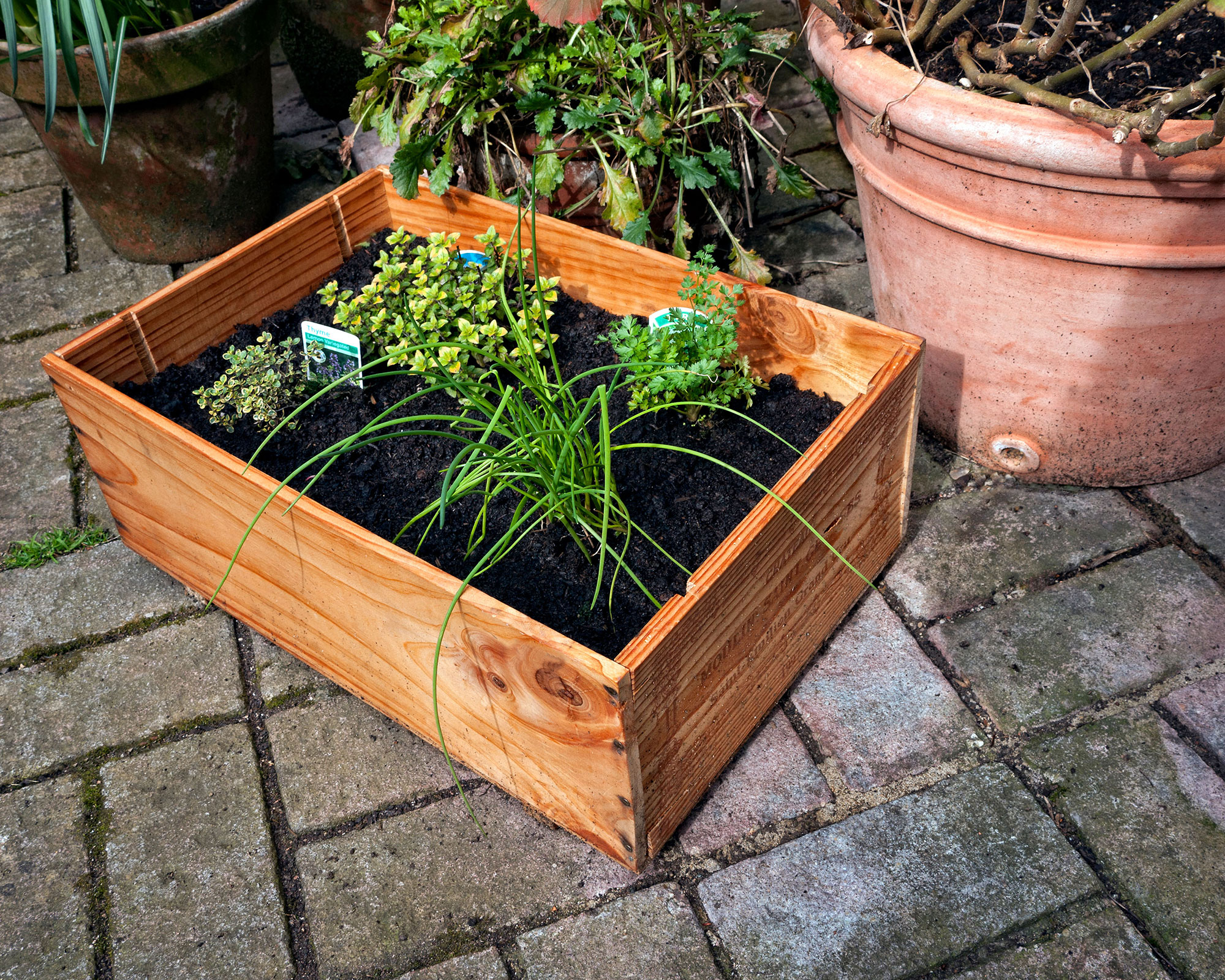
Traditional French wooden wine boxes are ideal for container displays and vintage-style ones are widely available online. Durable as well as looking decorative, they are roomy enough for planting up a good selection of herbs.
You will need to line the box with sturdy plastic, such as an old compost bag, and include drainage holes so the soil is free draining and your herb garden doesn't become waterlogged. Fill with good quality, peat-free, organic multi-purpose compost, and get planting your herbs.
If you want to include mint, be sure to plant it in its own separate pot which you position in the box first, then fill in with compost around it for planting the rest of your herbs. This will stop the mint from becoming invasive and taking over.
11. Choose a spiral herb garden
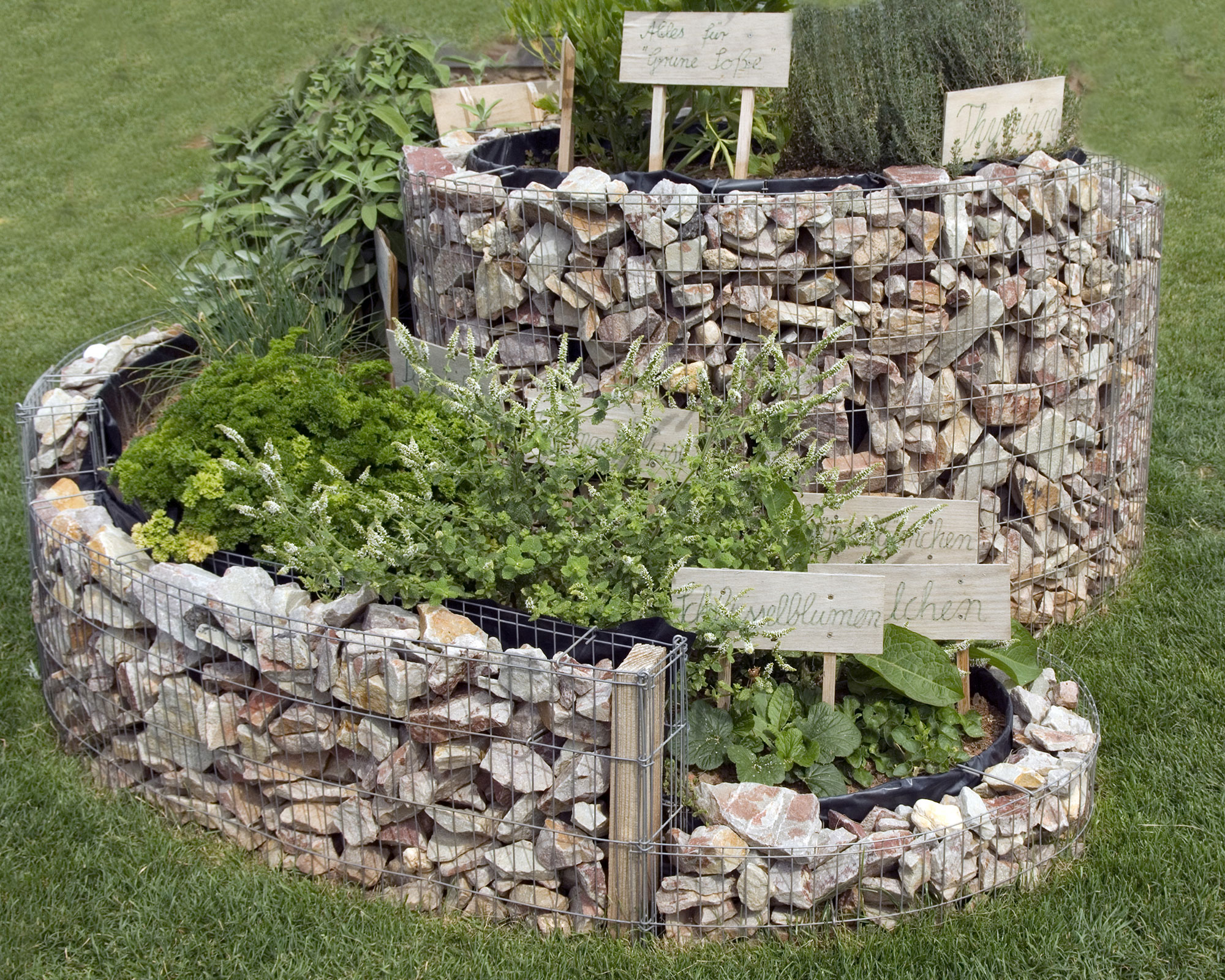
Choose a tapering herb spiral garden for a compact space-saving design that's both stylish and practical. It's a different take on vertical growing and one of the best herb garden ideas around.
A herb spiral is basically a small herb garden. The top planting area gets full sun and has better drainage, so herbs that like exposure to the sun and good drainage are planted there. The bottom area of the spiral is more suitable for herbs that need moist soil and less sun. The spiral herb garden gives you several zones with different soil characteristics and sun exposure to suit all your herb needs.
The structure is typically made of natural stone garden walls or bricks. Gabion walls work really well and add a contemporary touch, such as in the spiral herb garden shown here.
12. Grow herbs in raised beds
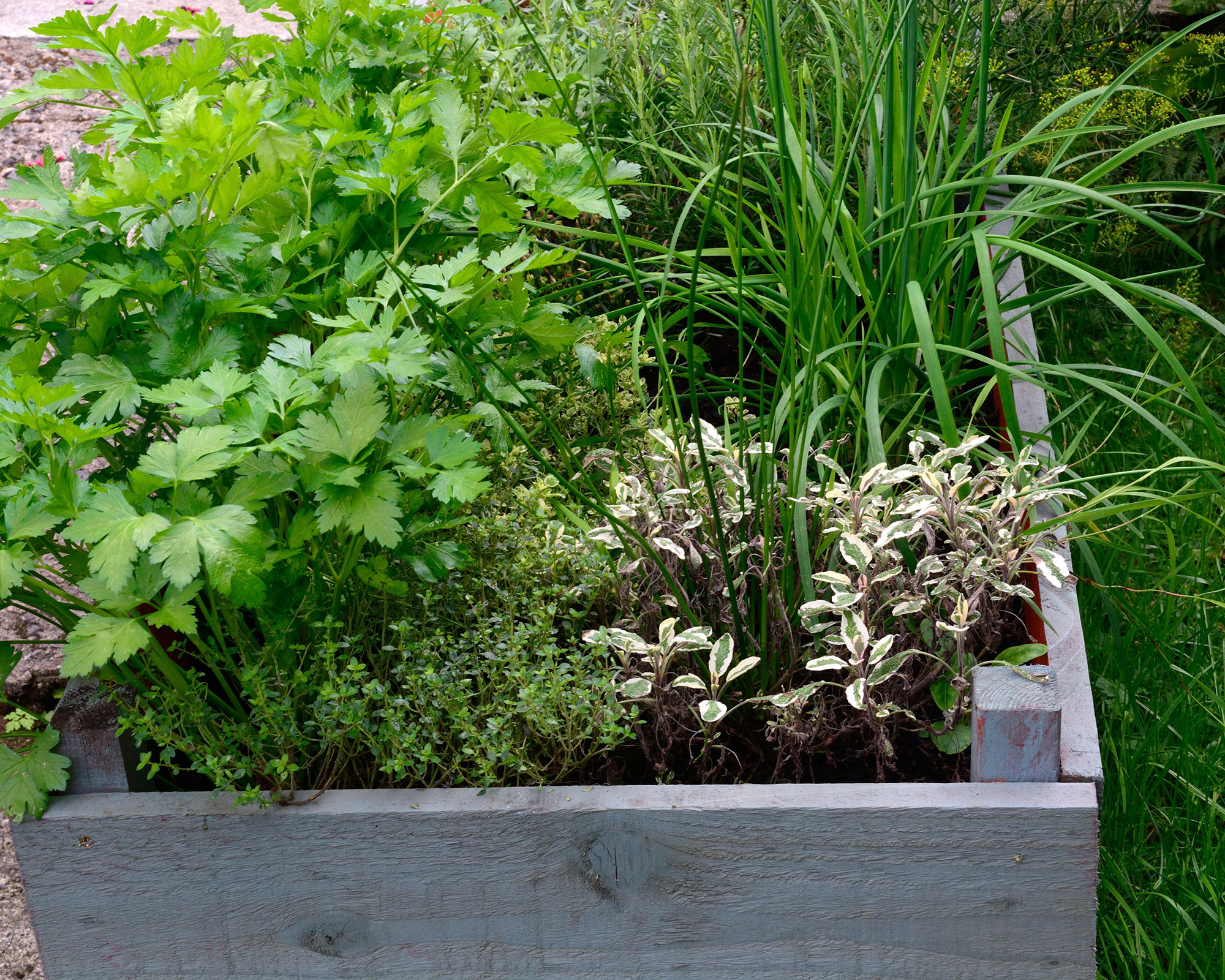
Herbs are some of the best plants to grow in raised garden beds as you can pack them in tightly together to get the biggest harvests. Oregano and thyme can grow in as little as 6in (15cm) of soil, but in general, aiming for around 12in (30cm) should cover it.
You don't need lots of space to include a raised bed either. Even a small patio area can accommodate a raised bed and they can be easier to look after than having lots of herbs scattered around in different pots. When working out the dimensions, bear in mind you should be able to get to the center of the raised bed from each side without having to tread on your crops.
If you're looking to build raised beds from wood, you can often find everything you need in building skips. Scaffolding boards are ideal. Use several coats of non-toxic paint if you want to smarten them up.
If you love this idea, find out the best vegetables to grow in raised beds, too.
13. Make a hanging planter
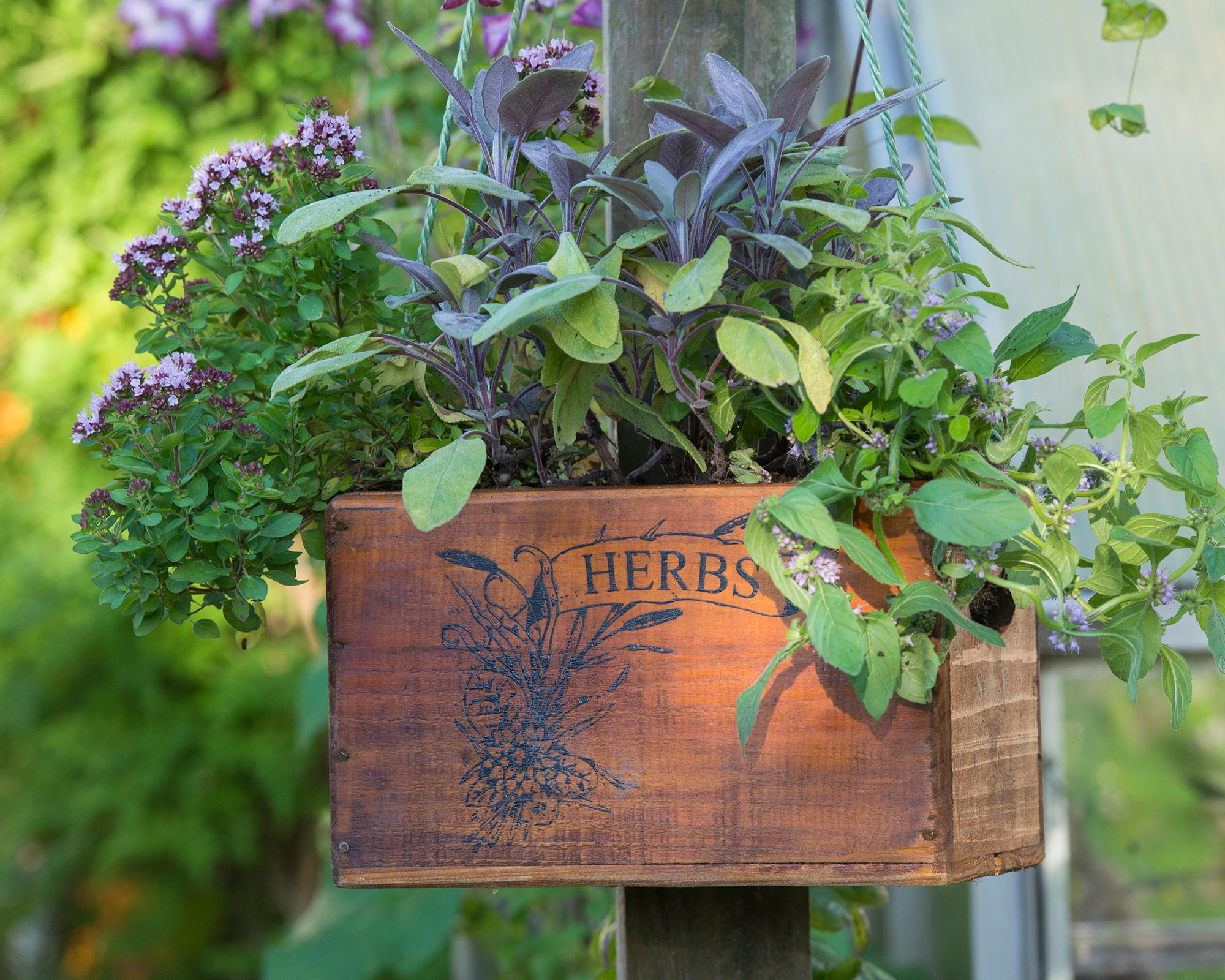
This is a different take on our earlier idea to turn a wine box into a planter, but this time around, you simply attach sections of rope so you can hang it up. It's a great space-saving idea for indoors and out if you're looking for compact herb garden ideas.
It's also nice to try your hand at adding a stenciled design such as a 'herbs' label. There's a wide range of stencils for wood (available on Etsy) to choose from so you can make your hanging herb planter unique.
14. Set up a herb plant theatre
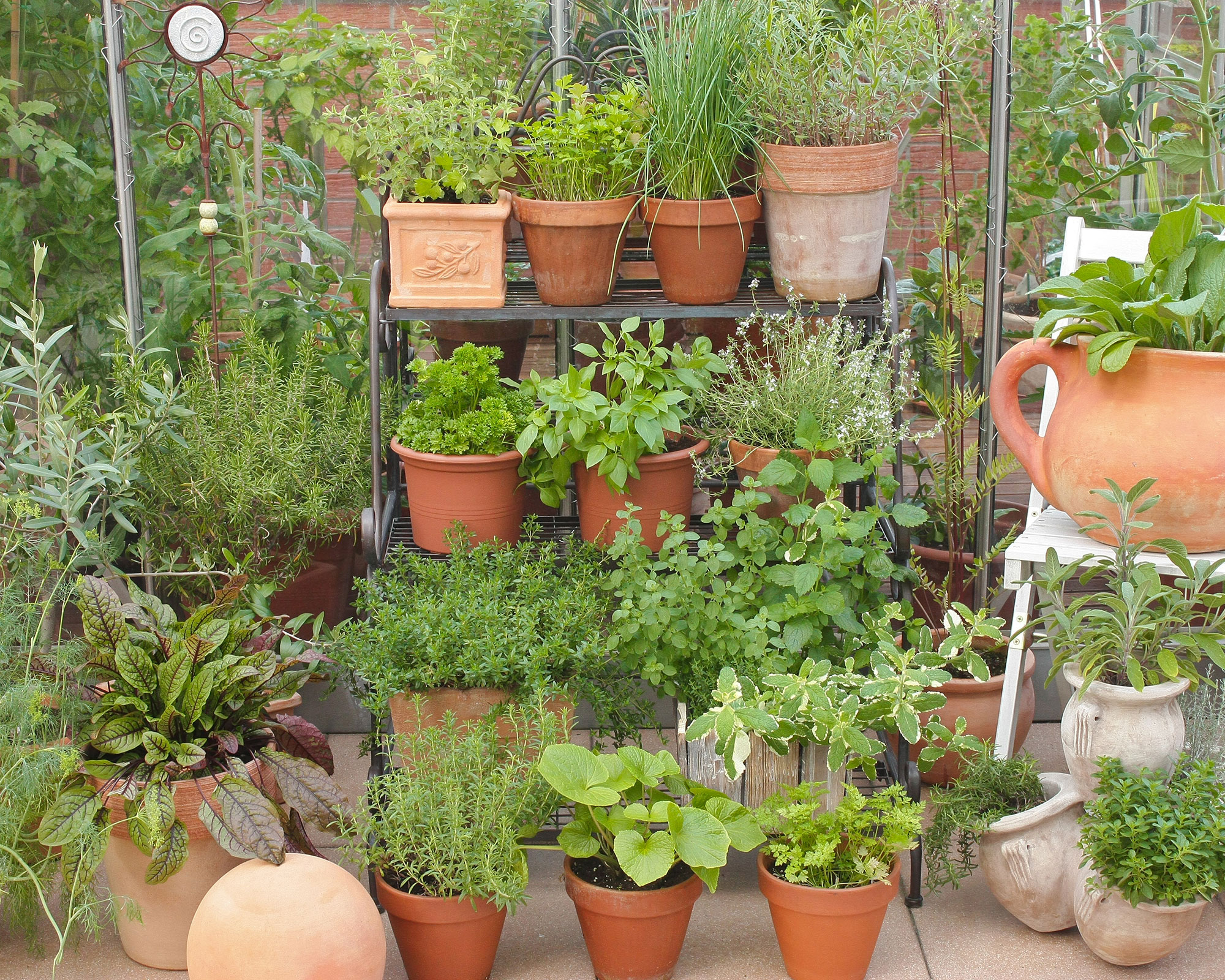
A good herb garden is all about easy access and easy maintenance. And an approach that ticks both these boxes is choosing a plant theatre and positioning it just outside your kitchen door. Rack up your herb plants in tiers and you can both keep an eye on them and pick them as and when you need them. What could be better for a low maintenance garden idea than that?
What's more, a plant theatre is a great way of showing off your herb collection, as well as any other collections of plants such as succulents or spring bulbs. Raising your plants on shelves lets you stage them and add some drama so it's one of our favorite herb garden ideas. You can also appreciate their charms better, as they will be at eye level.
15. Plant up a metal bucket
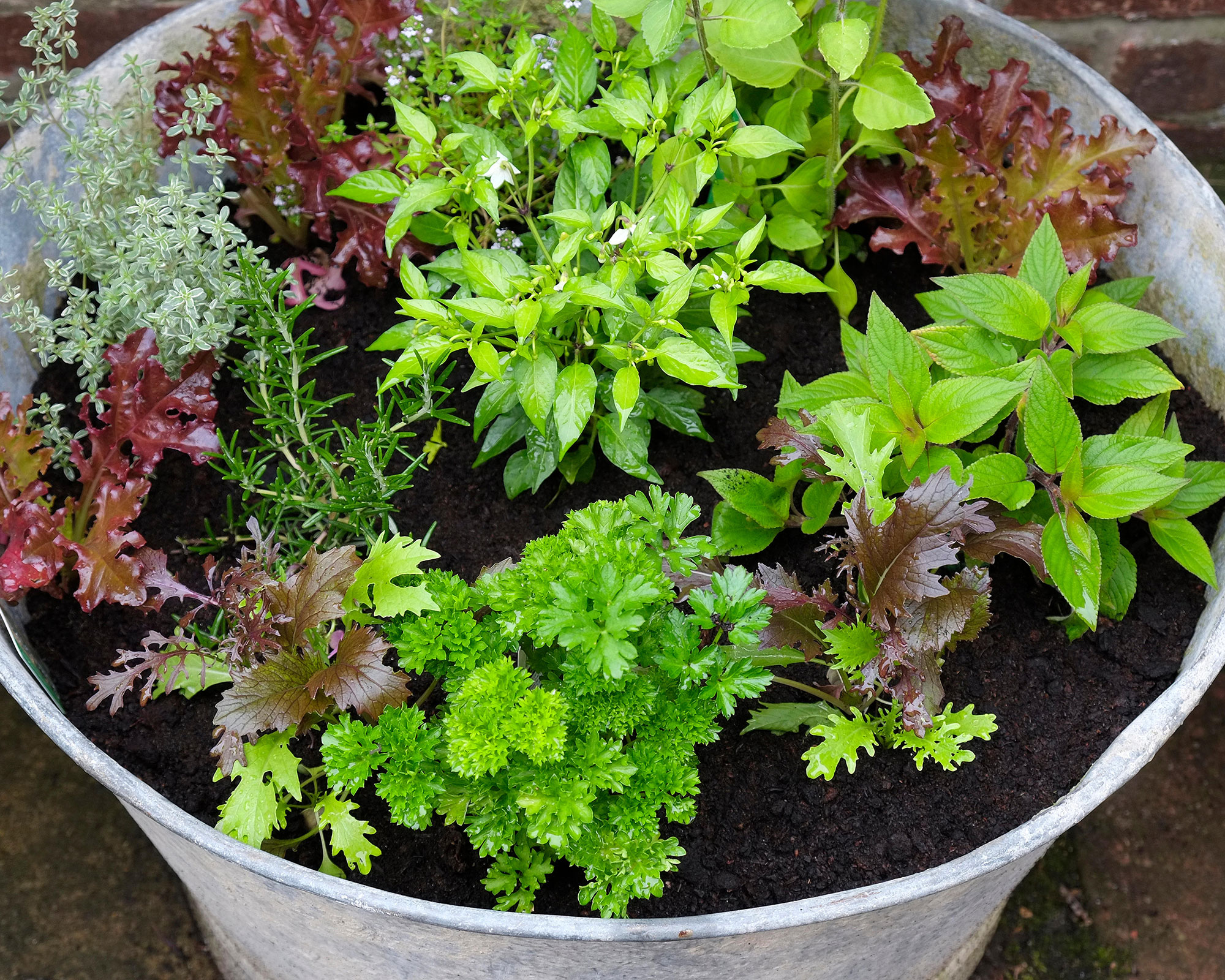
Galvanized metal containers are a good choice for herb gardens. Choosing a bucket makes life easy as it's portable, so you can move it from the kitchen door to an outdoor cocktail bar or barbecue area for handy garnishes as needed.
Check which herbs are happy being planted in the same garden planter. A mix of thyme, rosemary, parsley, sage, chives, and basil will work well. Try interspersing with some salad leaves too for variety.
16. Repurpose an old chest
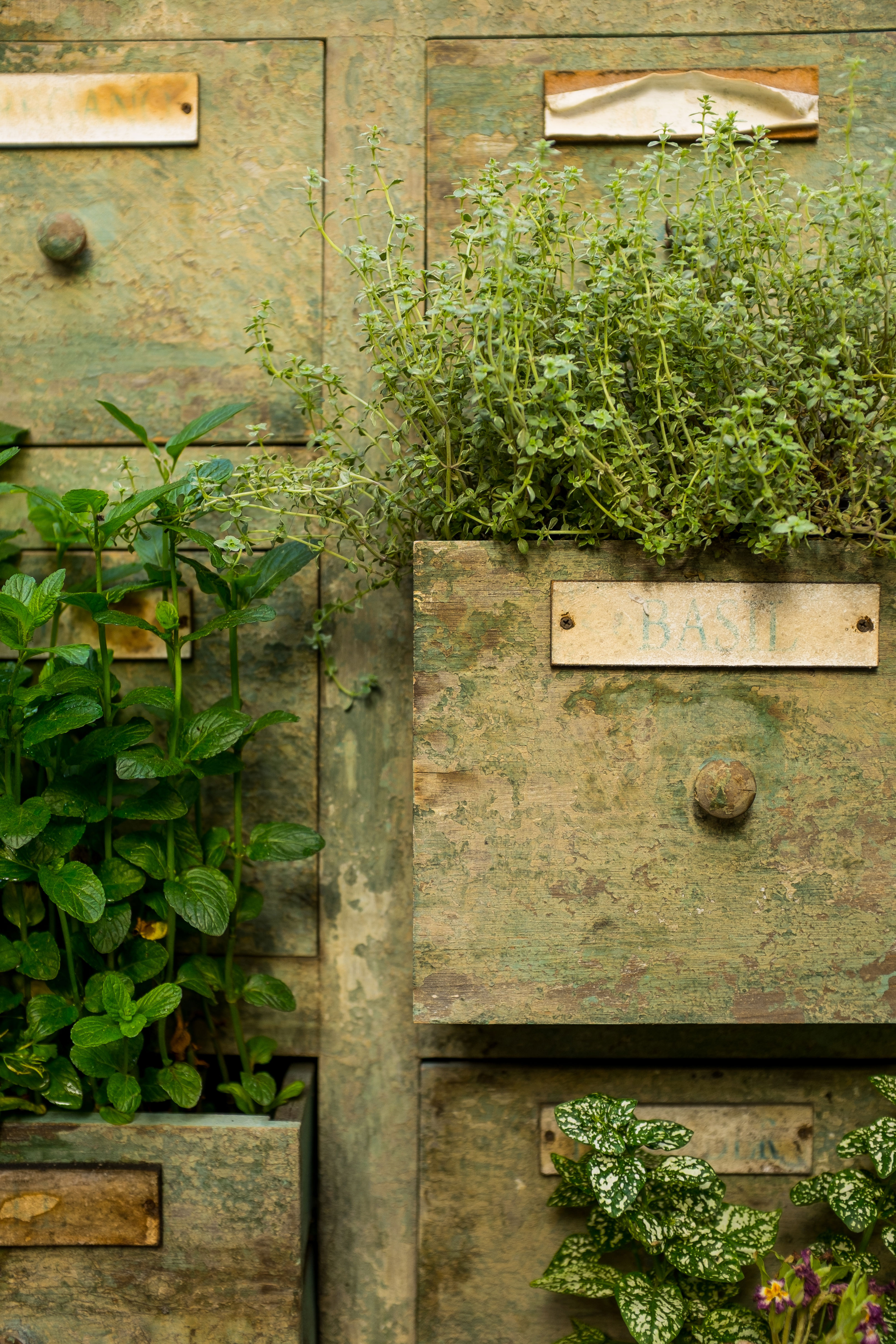
There is nothing we like more than upcycling a vintage chest to turn it into a stylish planter. Bric a brac and junk shops are great places to search for pieces that can be planted up for one of the best herb garden ideas that's very 'of the moment'.
The latest upcycling look is giving old chests and cupboards a new lease of life. It's a big trend on Instagram and Pinterest, where you'll find plenty of inspiration if want to take your upcycling game to the next level.
The more vintage the finish the better if you want to show off your plants in a quirky way, so go for wood that looks 'distressed'.
17. Make a pallet planter
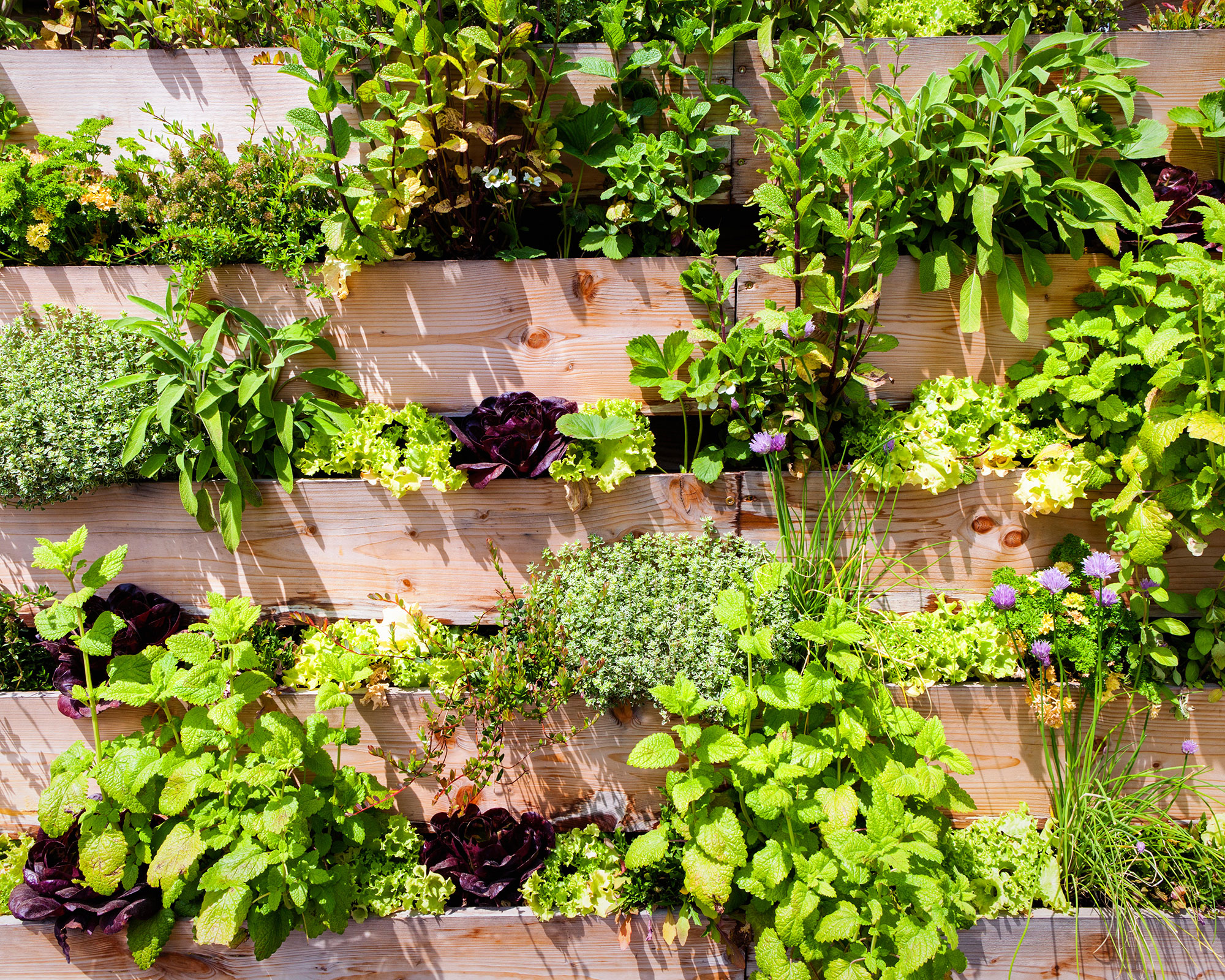
Repurposing pallets into planters has never been more popular, and is just one of the many pallet furniture ideas happening in a garden near you if not your own already.
To make a DIY pallet herb garden, find a pallet that is in good condition and hasn't been painted or treated in any way – you're going to be growing food crops in it so don't want to take any chances. You can add a couple of coats of timber stain to enhance the look of it if you like.
Create planting 'troughs' or 'pockets', then line each one with thick black plastic. Old compost bags are ideal for this. Make sure you include drainage holes, then fill with good quality compost and your choice of herb plants. It's really as easy as that!
18. Get creative with shelving
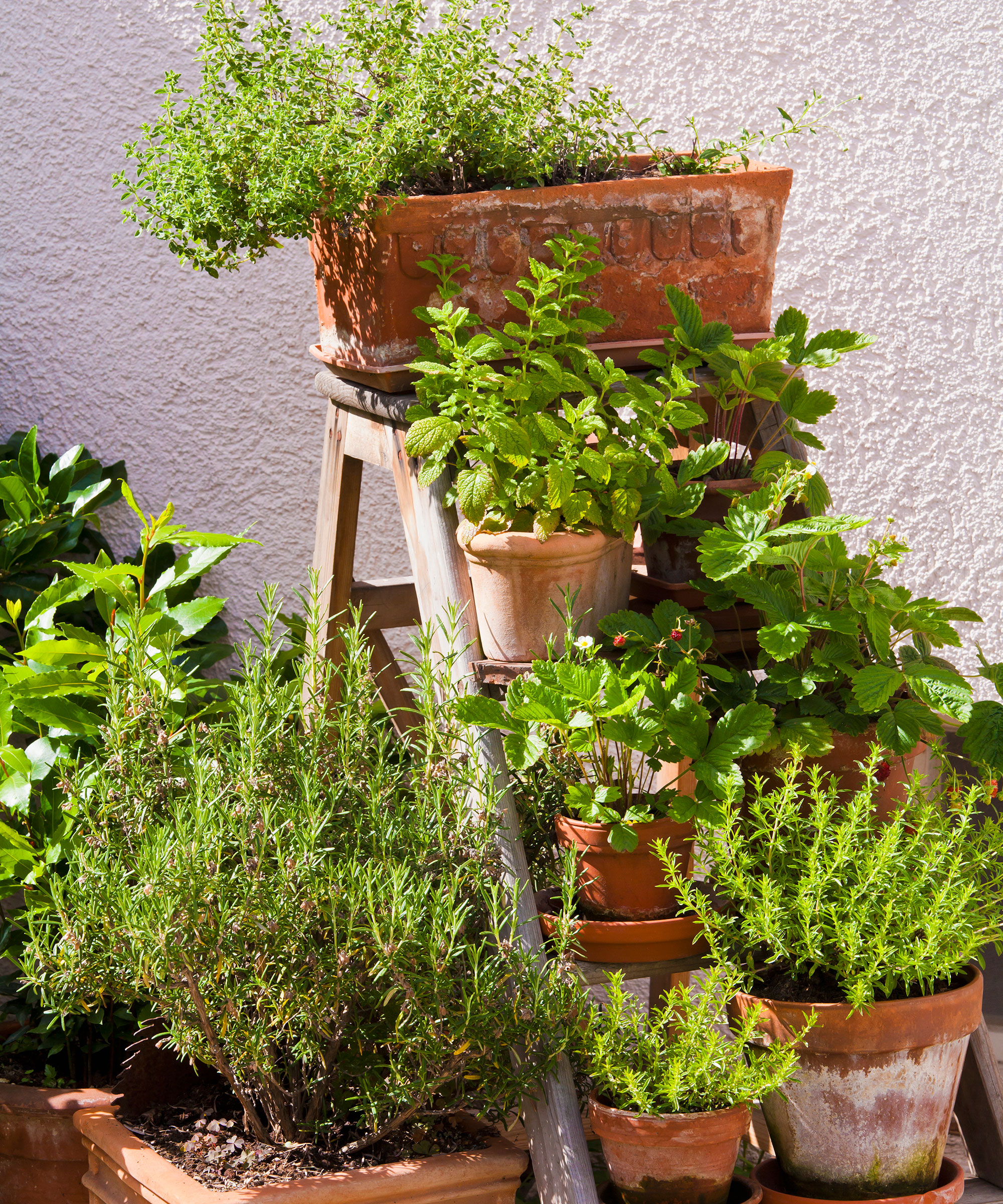
If you don't want to splash out to set up a herb plant theatre by buying one, try repurposing an old wooden stepladder to create an eye-catching display. It's amazing how many herbs you can cram onto one.
They are a perfect addition to laid-back, cottage garden ideas. You could even paint one in a pastel hue, think powder blue or soft white, for extra charm.
19. Make a geometric herb garden
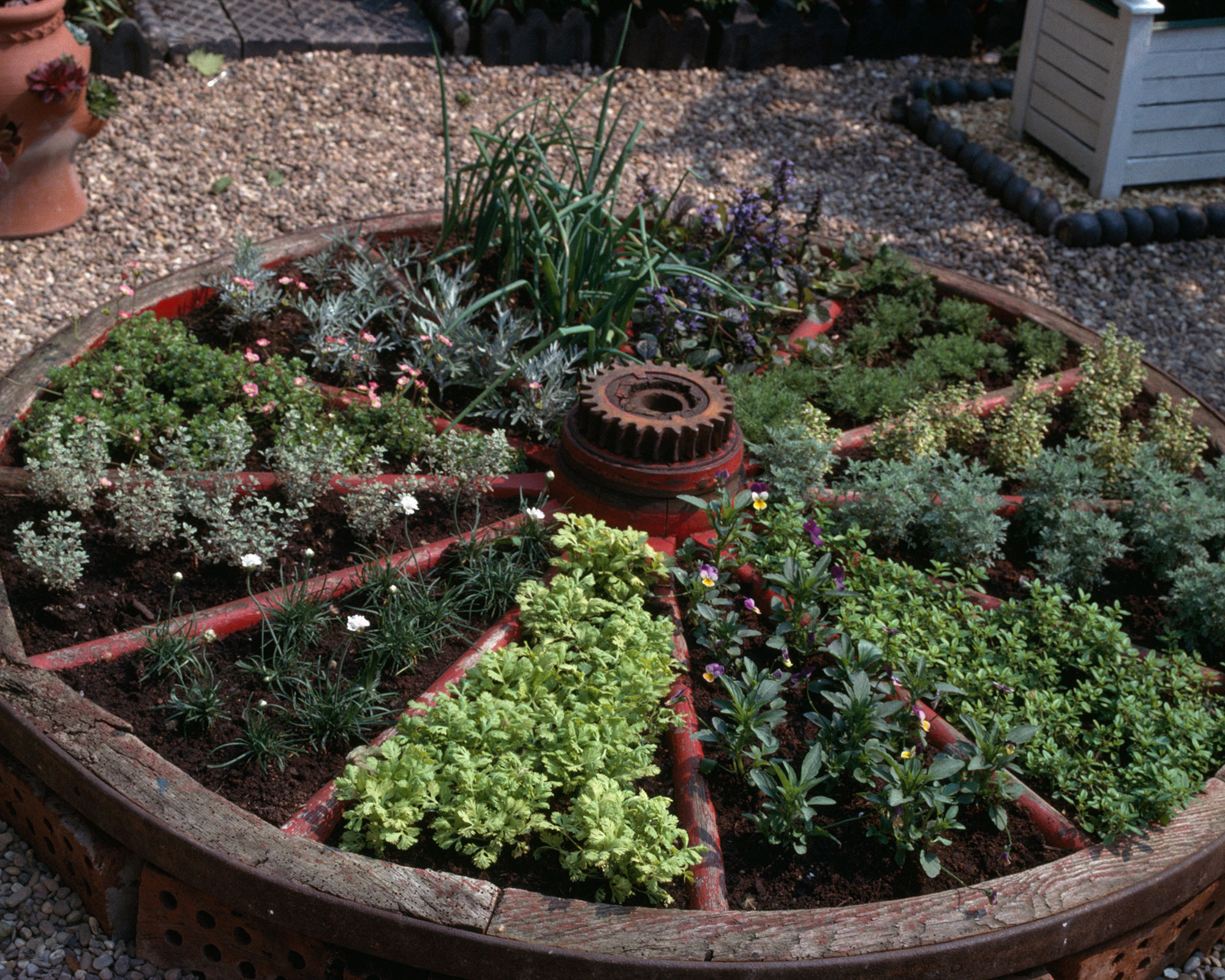
Show off the beauty of herbs with a more formal design in your potager garden. Since ancient times, herb gardens have been laid out in geometric patterns, and this parterre style suits small urban gardens equally well. It's a great choice if you're looking for garden design ideas and want to include herbs.
The parterre idea is a formal, symmetrical pattern with low evergreen boundaries of plants such as trimmed box. In this alternative take on the design, the spaces in between the spokes of this wagon wheel are filled with herbs to create a neat planting pattern. It takes all the headache out of the design process and is one of the easiest herb garden ideas to get a geometric layout.
Fill the framework generously, packing each section with different foliage textures, colors, or growing habits. Trim frequently to keep plants looking neat and don't forget to add the trimmings to the salad bowl or cooking pot.
20. Recycle tin cans creatively
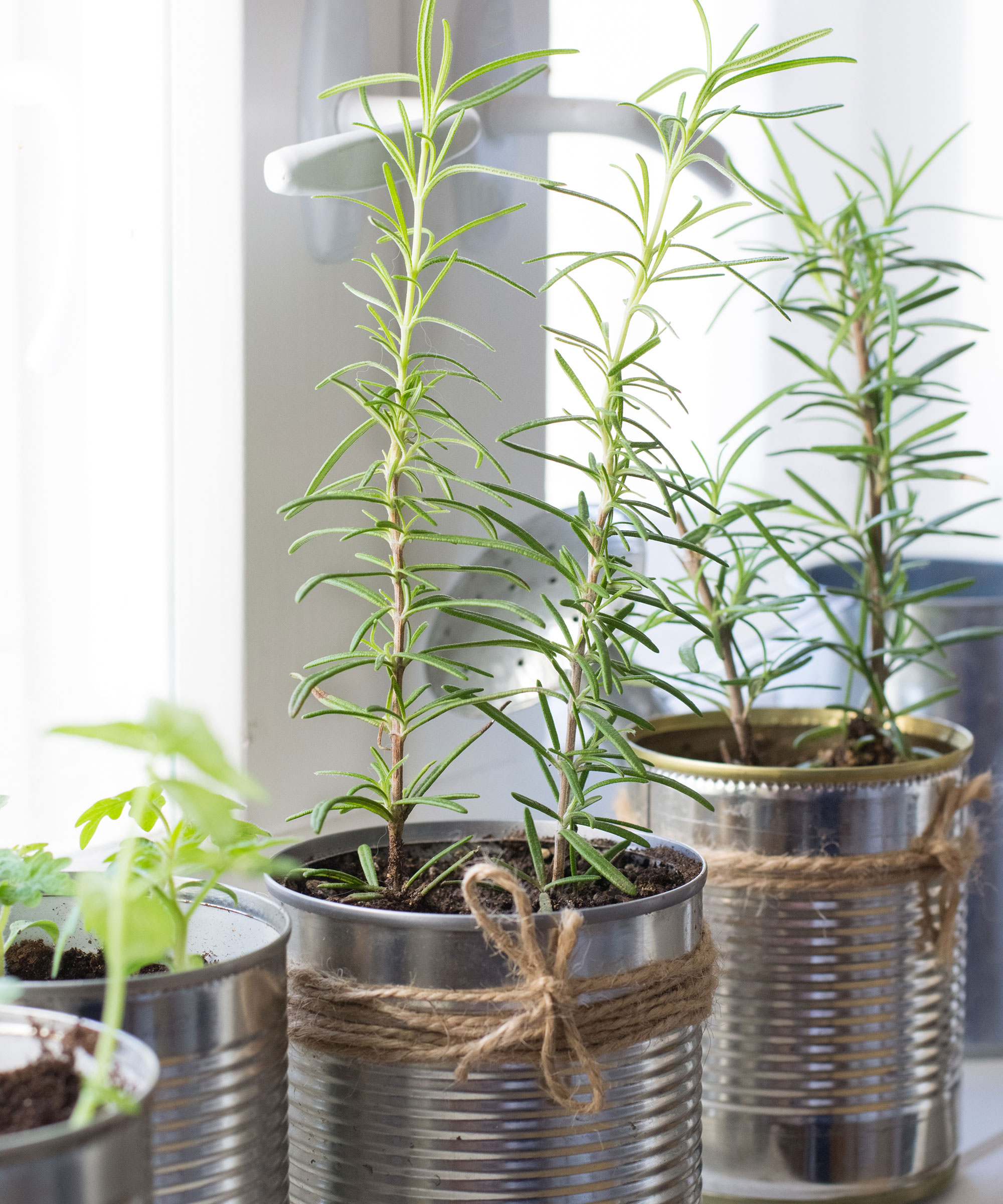
Whether you're making an indoor herb garden or an outdoor one, tin cans are really useful. Peel off the labels and naked tin cans look great and even better, they all match for a coordinated look. Add some of the best herbs to grow indoors and then line up rows of tins on the windowsill for a stylish display.
Sometimes it's worth asking at cafes and restaurants to see if they have any super-sized olive oil or tomato cans going spare, as these come with pretty designs on them and make great planters.
Food cans are the best to upcycle into planters as they have a coating inside to stop them from rusting. However, if they're not painted or varnished and left out in the rain, then they might rust on the outside.
Drill holes in the bottom of the cans to ensure good drainage, but you can probably get away with missing this step as long as you don't overwater the plants. Instead, add a layer of grit to the base before adding the compost.
As one of the easiest herbs around, this is a good option for growing rosemary. The string bows add a special little detail.
21. Look out for useful materials
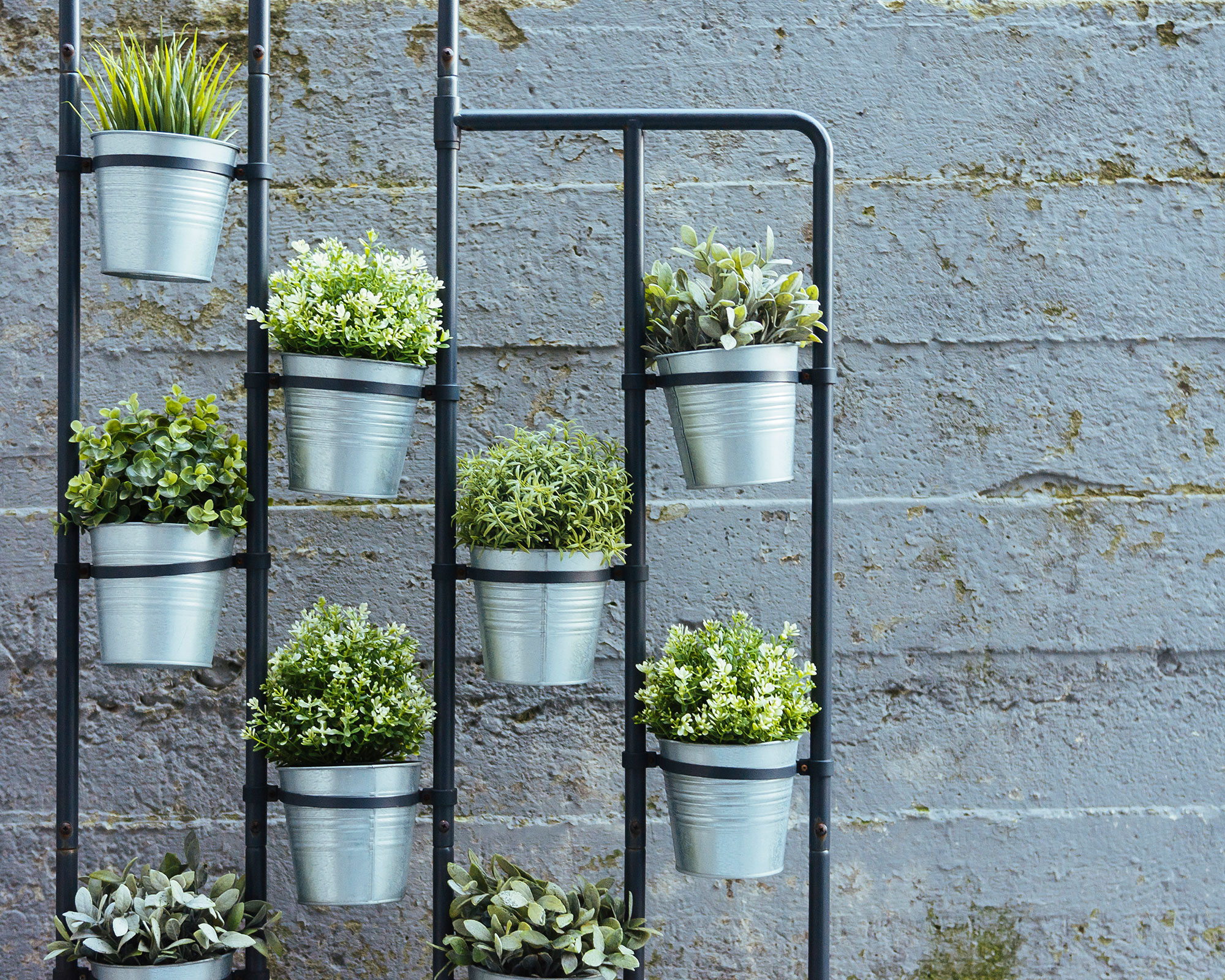
Sections of old iron or copper pipework, or rods from metal bed frames, make great frames to hang a collection of herb pots from. They can be reconfigured to come up with a framework design that suits your purposes, then spray painted for a sleek finish, or left as they are for a more industrial look.
It's such a simple idea but it looks so effective. When it comes to herb garden ideas the best thing is to use your imagination and come up with something that suits your style.
A design like this could also be a great way to zone an open-plan space in your home. An indoor garden planted up with lots of useful and tasty herbs definitely gets our vote.
What herbs can be grown together?
Group Mediterranean, sun-loving herbs like sage, thyme, rosemary, and oregano together as they all like the same growing conditions. Choose a sunny, sheltered spot and make sure the soil is gritty and free draining so the roots of the plants are not waterlogged.
Put shade-loving herbs like mint, dill, parsley, and chives together. These herbs don't like the soil to dry out, so tend to prefer shadier conditions. 'Herbs such as coriander, dill, basil, and wild rocket can be quick to bolt, especially if overcrowded, or in poor, dry soil,' warns the RHS. To be safe, you can make regular sowings to have a good supply of these crops.
Mint should always be grown in its own container, even if it's in the ground, as it's a prolific grower and can smother other herbs. By keeping it contained, you will give a helping hand to your other herbs.
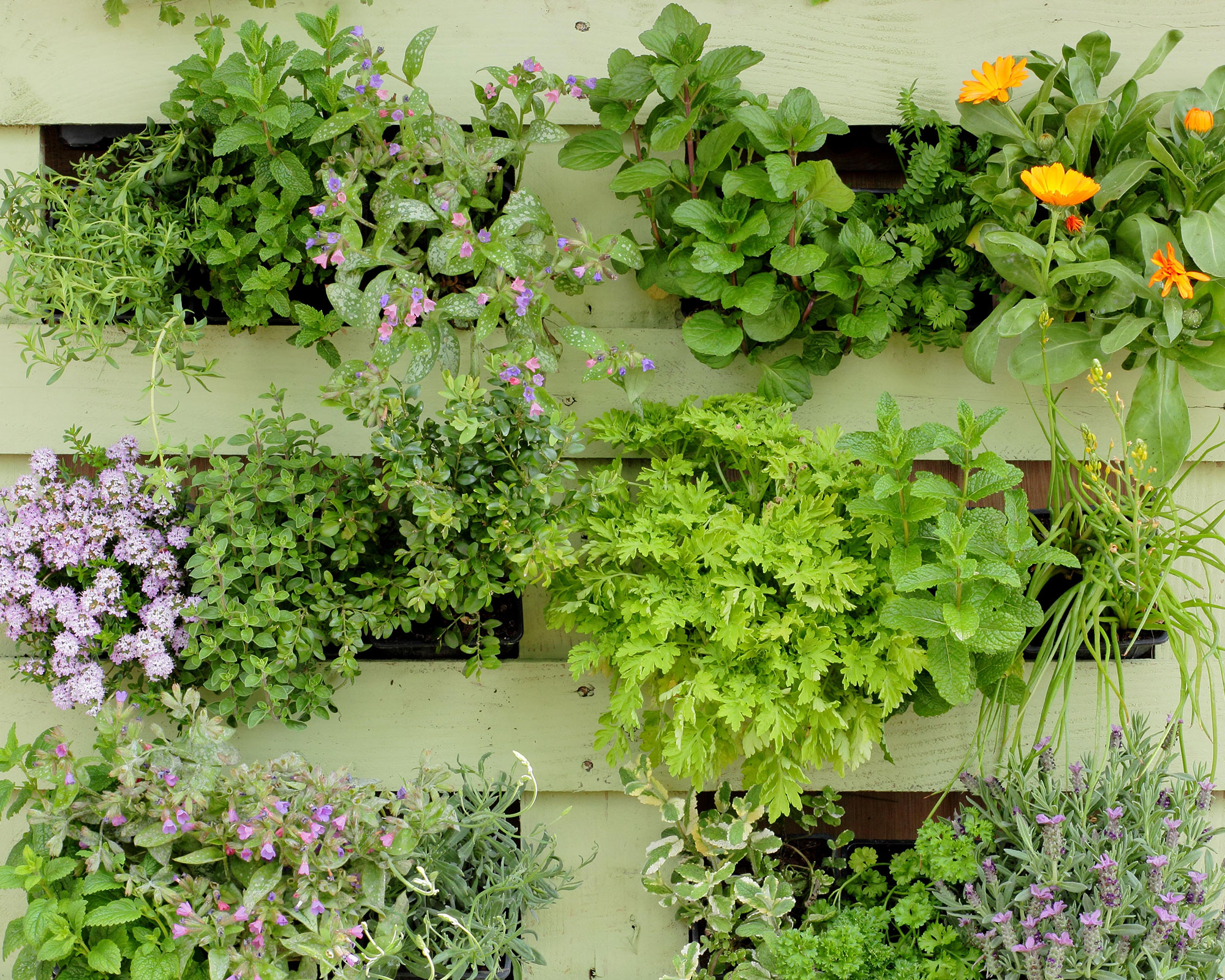
How do you start a herb garden for beginners?
Herbs are so much easier to grow than many other plants, demanding little but giving so much in return. Anyone can do it, whatever the size of your outdoor space.
Start off by growing herbs on a small scale with a collection of pots on the windowsill or include them in your patio gardening ideas.
Herbs take up much less time and space than vegetables, can be picked pretty much constantly throughout the year, and rarely need watering because so many of them thrive in hot, dry conditions.
Look at the space you have available and decide on the herbs you are most likely to use. If you have just a few pots on a sunny patio, your choice of herbs will differ from someone planning a larger herb garden.
Some of the easiest herbs to grow include rosemary, thyme, sage, chives, and basil. Our guides on how to grow thyme and how to grow basil are a great place to start if you want to include two of the best culinary herbs around.
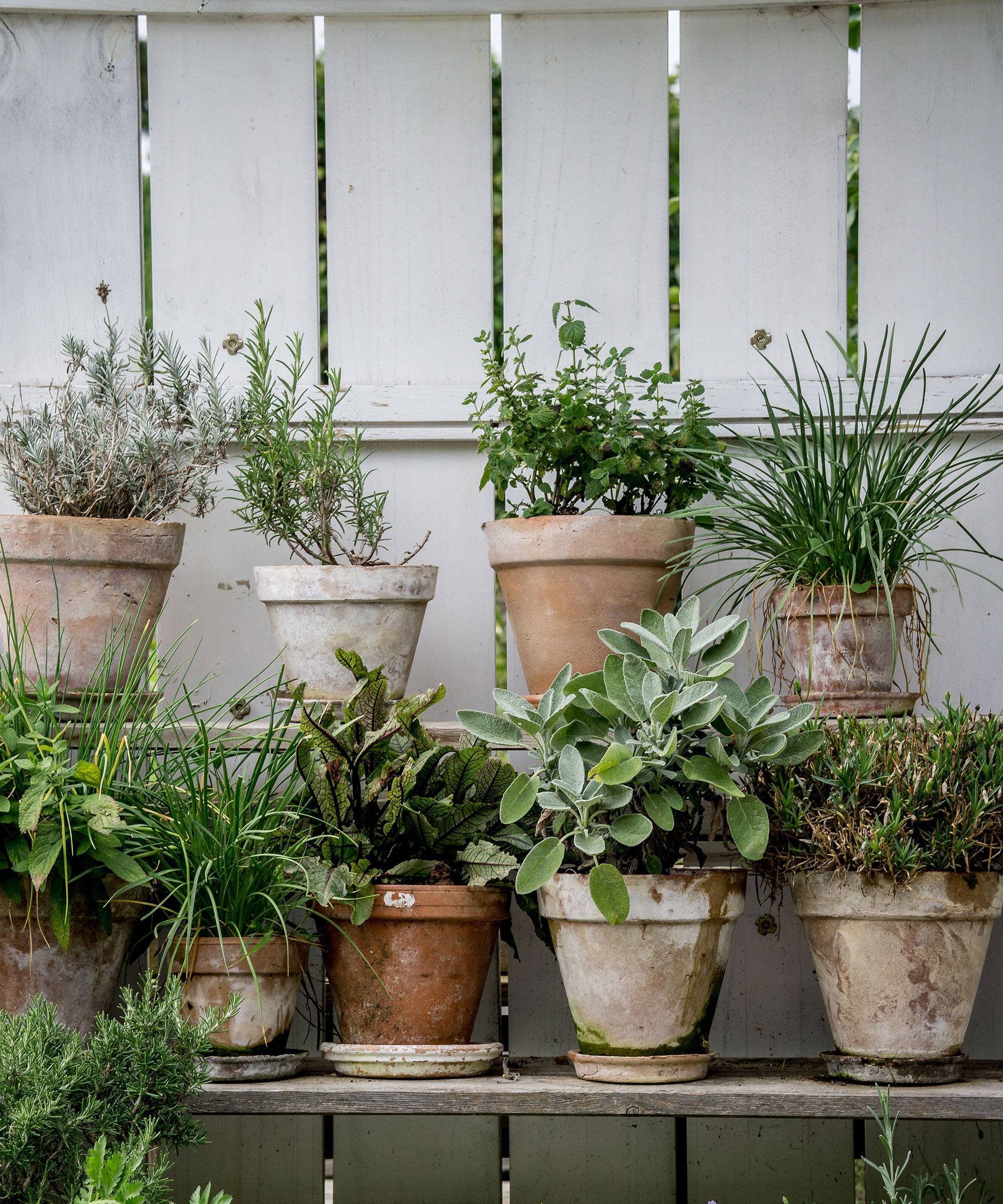
How do I make an outdoor herb garden?
If you have the space, do things on a larger scale with a separate herb garden, or by mixing in herbs with flowers and vegetables in the beds and garden borders.
Try planting a good herb selection among herbaceous plants in a mixed border. Tall architectural herbs like fennel work well at the back, while thyme, chives, and parsley are best at the front of a border. Herbs like rosemary and bay can be clipped to add structure.
If you want to create a separate herb garden, first draw up a plan. Remember herbs should always be planted near a garden path so they are easy to pick. You may like a natural design or something more formally laid out. Think about using small clipped box plants to create the structure if you want to go for a geometric design.
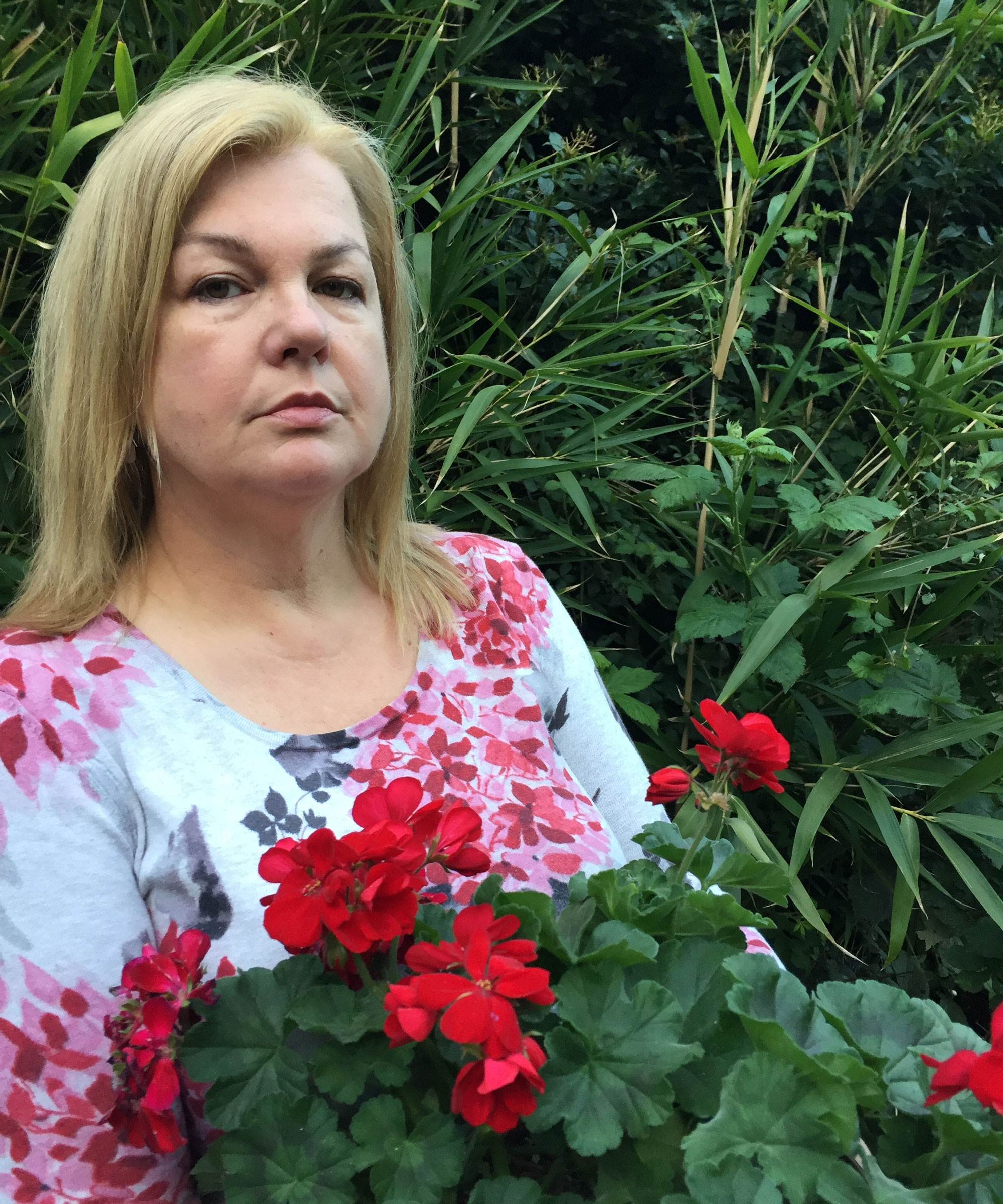
Lifestyle journalist Sarah Wilson has been writing about gardens since 2015. She's written for Gardeningetc.com, Livingetc, Homes & Gardens, Easy Gardens and Modern Gardens magazines. Having studied introductory garden and landscape design, she is currently putting the skills learned to good use in her own space where the dream is establishing a cutting garden.
- Holly CrossleyActing Deputy Editor
